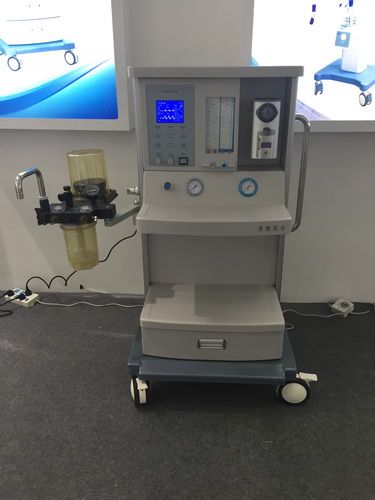Introduction
Anesthesia machines are critical in modern medical facilities, providing safe and efficient anesthesia delivery during surgical procedures. This guide will cover everything you need to know about anesthesia machines, answering common questions and presenting essential information in varied formats to maintain clarity.
1. What is an Anesthesia Machine?
An anesthesia machine is a device that delivers a controlled flow of anesthesia gas to patients undergoing surgical procedures. These machines ensure that patients remain unconscious, pain-free, and stable during operations.

2. Components of an Anesthesia Machine
| Component
|
Description
|
Gas Supply System
|
Supplies oxygen, nitrous oxide, and other anesthetic gases.
|
Vaporizers
|
Converts liquid anesthetic agents into gas for inhalation.
|
Breathing Circuits
|
Delivers the gas mixture to the patient and removes carbon dioxide.
|
Ventilator
|
Provides mechanical breathing support to the patient, especially during long surgeries.
|
Scavenging System
| Captures and removes excess anesthetic gases from the operating room to ensure safety. |
By understanding these core components, you can better appreciate how anesthesia machines function as lifesaving equipment in medical environments.
3. Types of Anesthesia Machines
When it comes to anesthesia machines, there are two main types commonly used in medical facilities:
Type
|
Description
|
Continuous Flow
|
Provides a steady flow of gases and is more commonly used in hospitals and complex surgeries.
|
Draw-Over
| A simpler, portable version often used in field surgeries or smaller medical facilities where mobility is crucial. |
The choice between these types largely depends on the complexity of the surgery and the location of the facility.
4. How Anesthesia Machines Work: A Step-by-Step Process
To demystify the process, here’s a simplified step-by-step breakdown of how an anesthesia machine works:
- Gas Supply: The machine draws in medical-grade gases, such as oxygen and nitrous oxide.
- Vaporization: The gases pass through a vaporizer where they mix with volatile anesthetics.
- Delivery: The gas mixture is delivered to the patient through a breathing circuit.
- Monitoring: Sensors constantly monitor gas concentration, patient vitals, and pressure levels.
- Exhalation: Exhaled gases, including carbon dioxide, are removed from the breathing circuit and often scavenged to prevent environmental contamination.

5. Essential Features to Look for in Modern Anesthesia Machines
Modern anesthesia machines come equipped with advanced technology, enhancing safety and efficiency. Some essential features include:
- Electronic Monitoring: Tracks the patient’s oxygen levels, heart rate, and anesthetic gas concentrations.
- Automatic Alarms: Alerts medical staff if any parameter is out of the safe range.
- Touch-Screen Interface: Allows for easy control and customization of anesthesia delivery.
- Advanced Ventilation Modes: Supports patients with varying respiratory conditions.
6. Anesthesia Machines: Key Differences in Hospital and Outpatient Settings
Feature
|
Hospital Settings
|
Outpatient Settings
|
Size and Complexity
|
Larger, more complex machines to accommodate longer surgeries.
|
Compact machines designed for shorter, simpler procedures.
|
Monitoring Systems
|
Extensive patient monitoring systems for critical care.
|
Basic monitoring systems, often mobile and adjustable.
|
Cost
|
Higher due to advanced technology and features.
| More affordable and portable models available. |
The main differences lie in size, portability, and the complexity of features, with hospitals typically opting for more sophisticated machines.
7. Cost of Anesthesia Machines and Maintenance
The cost of anesthesia machines varies widely based on type, features, and brand. Here’s a general cost breakdown:
- Standard machines: $30,000 - $50,000
- High-end models: $75,000 - $150,000
- Portable machines: $5,000 - $15,000
Additionally, regular maintenance is critical to ensure safe operation, costing about 5-10% of the machine’s initial purchase price annually.
8. Future Trends and Technology in Anesthesia Equipment
The future of anesthesia machines lies in the development of smarter, more automated devices. Emerging trends include:
- AI Integration: Smart machines that adjust anesthesia delivery based on real-time patient data.
- Wearable Monitoring Devices: Allow continuous monitoring of vital signs, even post-operation.
- Environmentally-Friendly Anesthetics: New anesthetic gases that have a lower environmental impact.
9. FAQs on Anesthesia Machines
To address common concerns, here are answers to frequently asked questions about anesthesia machines:
Q: How often should anesthesia machines be serviced?
A: Regular servicing is recommended every six months or after every 1,000 hours of use to ensure safety and compliance with healthcare standards.
Q: Can anesthesia machines be used for all types of surgeries?
A: Most modern anesthesia machines are versatile enough to handle a wide range of surgeries, but specialized surgeries may require specific machines.
Q: What are the risks of using outdated anesthesia machines?
A: Outdated machines may lack modern safety features, leading to potential risks such as improper gas delivery, system failures, and inadequate patient monitoring.
Conclusion
Anesthesia machines are an indispensable part of modern medical care, offering a critical service in maintaining patient safety and comfort during surgical procedures. By understanding the types, components, and innovations of these machines, medical professionals can make informed decisions when equipping their facilities.